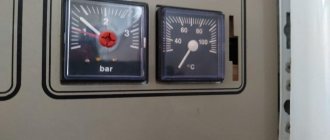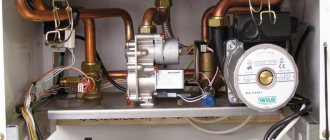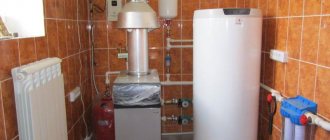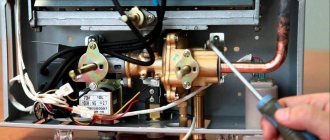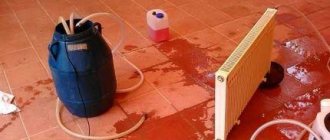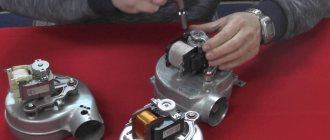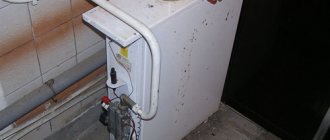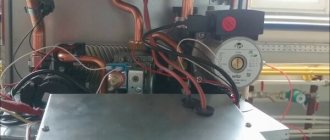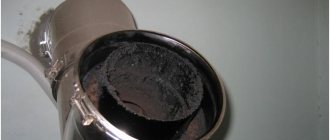Installing a gas boiler allows you to forget about cold water in radiators and taps. Double-circuit models are capable of simultaneously operating for heating and hot water supply (DHW) of a room. But what to do if the boiler does not heat the water? If you encounter a similar problem, our recommendations will help you find the cause and fix the problem yourself.
Gas pressure at the entrance to the house has decreased
A gas boiler may not reach temperature due to low gas pressure. Typically, a sensor is installed at the entrance to the boiler to measure pressure. First of all, its indicators are checked to make sure of this malfunction.
Also read with this article: What to do if the pressure in the gas boiler increases
Modern heating equipment is often equipped with a pressure reducer. Adjusting the values on it helps solve the problem described. For private houses with one or two floors, the optimal value is from 1.5 to 2 atmospheres. In houses with more than two floors, the gas pressure should be in the range from 2 to 4 atmospheres.
ATTENTION. Any boiler adjustment requires a careful approach with preliminary study of the instructions. Gas is a dangerous flammable component that can lead to explosions and fires if consumed incorrectly. If you doubt your own abilities, contact a company that services gas installations.
Expert advice on preventing extraneous noise and sounds
Some types of noise in heating communications can be removed independently or their occurrence can be prevented during the design and installation of heating.
If the batteries in a multi-storey building are connected without a bypass, during repairs it is impossible to change the pipes to communications of a smaller diameter. You cannot turn off the radiator using taps - you will leave your neighbors without heating, and they will not thank you for it. If there is no bypass, thermostatic valves cannot be used.
The recommendation of experienced plumbers is to use radiator taps, not radiator valves. Their design is more reliable, there is less hydraulic resistance, and there is no stagnant zone where debris accumulates. It is also better not to install valves. The advantage of using ball radiator valves is that the direction of water flow does not matter to them. In case of incorrect installation, the direction of the coolant flow will not affect them.
The video shows some ways to get rid of noisy heating pipes.
The insertion was carried out poorly: the diameter does not match or there are narrowings in the gas pipeline
A common reason for a complaint that a gas boiler in a house does not heat well is poor-quality connection of heating equipment to the general gas supply system (gas pipeline).
Often, gas service workers weld an additional thread, screw a tap onto it and drill a small hole where the thread joins the gas pipe. The diameter of such a hole is much smaller than the diameter of the pipe, which leads to a drop in pressure. As a result, the gas boiler does not heat hot water well.
Correct connection requires compliance with certain rules and takes more time. Therefore, negligence occurs frequently.
You can determine this reason in the following way:
- there is a sharp decrease in the flame after ignition of the boiler;
- stops gaining temperature, or the flame goes out on its own.
Special calculators are used to calculate the required diameter of pipes in a particular room. The power of the boiler requires a larger volume of gas supply, therefore it is necessary to use pipes with a larger diameter. Before connecting the boiler to the gas pipeline, you must call a qualified specialist who will calculate the required diameter for the pipes, taking into account the characteristics of the room and the power of the boiler.
The following factors influence the choice of a larger cross-section in the connected pipes:
- low pressure requires connection to pipes with a large diameter;
- boiler power and room area affect the diameter;
- the longer the system, the larger the cross-section must be used;
- a reserve in diameter is necessary when there are many turns in the system (gas flow slows down at turns);
- number of consumed points;
- the required room heating temperature with the water heating temperature for domestic use;
- what pump is installed in the boiler.
Why the boiler does not heat well and does not reach temperature
No hot water? For what reasons does the equipment not work? Sometimes it's a matter of external factors. Let's take a closer look.
The device works, but does not heat or heats poorly
Airlock. Check to see if air has accumulated in the batteries. Use taps to remove excess air. If you don't have an air vent on your radiators, then you need to install one. By adjusting its tap, you can release the accumulated air in the system.
Also inspect the valve for blockages. Most often it becomes clogged with scale.
Clogged radiators . After cooling, drain the water from the pipes. If it is very dirty, run it through the batteries until it comes out clean.
Incorrect connection . If there is no hot flow, make sure that the diameter of the pipes corresponds to those stated in the instructions. Are the hoses connected correctly and the shut-off valves installed?
Low pressure in the line . It is not enough to open the valve and ignite the burner. Add water.
Scale accumulation in the heat exchanger. You may notice that the equipment takes a long time to heat up the liquid, and the batteries heat up slightly. Clean the radiator tubes from deposits. To do this, it is better to remove the unit, but this cannot be done in all models. Therefore, remove the casing and disconnect the device from gas and water. Connect the tubes from the pump to the heat exchanger and circulate the cleaning liquid through the system. Special products can be selected in the store. Then rinse the parts with running water.
Adding reagents to the coolant fluid helps reduce the formation of salts on parts.
When purchasing, it is important to pay attention to the brand and model of the boiler. For example, Electrolux, Arderia, Ariston, Buderus prohibit the use of the reagent. It is recommended to install cleaning filters or use distilled water.
Antifreeze can be applied to Baxi, Beretta, Vaillant, Proterm, Celtic, and Korea Star models. But a separate reagent is produced for each manufacturer.
Filter clogged . Another reason for poor battery warm-up. The mesh filter becomes clogged with small debris, so it is periodically removed and cleaned under running water. If the part is severely clogged or worn, it is better to replace it.
Incorrect adjustment . Check the set values on the panel. The temperature may be set too low, so the gas is not heating the hot water.
Problems with the operation of the circulation pump . Overheating, the pump turns off when hot water is turned on. Its power may not be enough for normal circulation. Adjust settings.
The battery design is not suitable for your equipment . Each design has its own permeability and heat transfer. An incorrect choice leads to a decrease in heating due to the permeability of the system.
Failure to comply with the slope of the highway . The problem is typical for systems with natural circulation, which is ensured by compliance with installation standards. According to the documents, the slope of the pipes for each linear meter must be at least 10 mm. No slope - no heating. The coolant stagnates, the batteries remain cold.
The gas boiler does not turn on, does not provide hot water for hot water supply
The main cause of malfunctions is salt deposition . The larger the scale layer in the heat exchanger, the worse the conductivity. The water takes a long time to heat up, and a thin, slightly warm stream flows out. Also, a piece of scale could break off and block the passage to the mixer. We described above what to do in this situation.
Problems with the flow sensor . The part works on the principle of a fan, which rotates due to the movement of the flow. The sensor may not work if there is a blockage. To clean without dismantling, open and close the tap located near the circulation pump.
If the procedure does not help restore operation, you will have to remove the sensor, clean it and reinstall it.
Three way valve malfunction . If the valve is jammed or broken, it will not be possible to switch the water supply from the heating system to the domestic hot water supply. The cause of the problem could be a clogged part, gas hose or filter. Clean all elements.
There are many reasons for malfunctions. The signs we describe will help you determine what problem has arisen in your circuit. Pay attention to the operation of the equipment and compare with the indicated problems. If you cannot fix the problem yourself, contact a specialist.
Discrepancy between the volume of water consumed and the power of the boiler used
If residents complain that there is no hot water coming from a gas boiler in a private house, the reason may be the fact that significantly more hot water is consumed than the boiler can physically heat. Heating hot water in a boiler is not an instantaneous operation. Therefore, the volume in the coolant must fully correspond to the amount of consumption.
The room is heated by water flowing in pipes (batteries). While it makes a full circle, it cools down. Therefore, during this time, a single-circuit or double-circuit gas boiler in a private house must heat the water for the next circle so that the circulation of the warm flow is continuous.
Efficiency of the proposed method
At a relatively low cost, installing a water heater, expander and pump allows you to:
- save up to 25 thousand liters of water per year if a family of four lives in an apartment,
- use water at a comfortable temperature even if several water intake points are operating simultaneously,
- reduce gas and electricity consumption,
- extend the service life of a double-circuit boiler.
One of the best in terms of price-quality ratio are Korean gas boilers Navien. These units have a lot of advantages, are quite reliable and inexpensive. However, during the operation of Navien gas boilers, malfunctions also occur. Let's look at what they are connected with and how to eliminate them without resorting to the help of specialists.
Too much draft in the chimney
High-quality supply ventilation in high chimneys leads to strong draft. Too much draft blows the flame away with strong gusts of wind, like outside.
Read more in the article: Why does the wind blow out a gas boiler?
Consequently, a gas boiler does not heat running water in the system well. To understand this reason, you need to imagine a burning fire in the middle of a field with a strong wind (the flame will also be blown out by the wind).
The normal indicator is changing the air in the boiler room three times. Sometimes, the indicator reaches ten or fifteen times during the period of heating the water for the next circle. Modern heating systems are equipped with special systems (dampers) that regulate draft. However, many older models remain sensitive to the force of the air flowing outside.
How to repair the system
Initially, to determine whether the pump is faulty, you should check the operation of the rotor; to do this, you need to unscrew the plug nut at the end of the pump. When unscrewing, a small amount of water will flow out. Next, you need to insert a screwdriver inside and turn the pump shaft.
If air has accumulated in the pump, open the air vent and bleed it. The air vent looks like a cap that rises up and rotates around an axis. At the moment of descent, a certain hissing sound will be heard, as if you deflate a balloon. If all these manipulations do not help, you will have to replace the faulty part with a new one. Since repairs are quite difficult to perform, and the service is not cheap.
Important: If you do not have enough qualifications in boiler repair, it is better to invite a specialist from the service department. Since incorrect actions during your repair process can cause even greater damage to the boiler. And in the case of gas boilers, this is also life-threatening.
Problems with setting the boiler gas valve
It is necessary not only to install the device correctly, but also to set up hot water on the gas boiler. If this is not done, the outlet pressure may be lower or higher than the specified norm, as well as a number of other errors made by unqualified specialists.
In this case, the device will operate at only part of its capacity. Consequently, heating in a room with a heating boiler will be less efficient. If this reason is identified, it is necessary to call specialists from the service company to eliminate the error.
We recommend reading with this article: How to properly configure a heating boiler
What should you do first?
First, check whether the wall-mounted boiler really does not heat the water. The design of any boiler involves technical limitations. This also applies to preparing hot water. A 24 kW gas boiler can heat 12 liters of water. The temperature difference will be around 35 degrees. You can clarify the technical characteristics of your device by reading the instructions for it. Any deviations from the parameters specified in it indicate a malfunction of the device. Some gas boilers today are equipped with a diagnostic system that displays an error code on a special display. The instructions will also help you decipher these codes.
Gas filter clogged
It is installed at the inlet of the boiler to further filter the incoming gas. Protects heating equipment from substances that cause malfunctions. A clogged gas filter delays the flow of gas, which reduces the combustion force, and accordingly the temperature in the house will drop.
The degree of contamination is assessed visually when the filter is unscrewed from the boiler. It is necessary to perform such a manipulation when the equipment is completely turned off.
Attention: A dirty filter must be replaced with a new one.
what is this, photo of the circuit for this type, why does the water boil quickly in the expansion tank
The main difference between open or gravity systems (OS) and closed ones is that in the OS the coolant communicates with the surrounding air in an open expansion tank.
The coolant is in the system under atmospheric pressure, there is no excess pressure.
Odnoklassniki
Description of an open type heating system: what is it?
The OS heating circuit consists of a boiler located at the lowest point of the building - the basement or pit.
A vertical coolant supply riser extends from the boiler to the top point of the building (attic or attic), where the expansion tank (RB) is located.
Horizontal pipes with a slight slope extend from the RB along the top of the building to vertical risers, through which the coolant is delivered to the radiators.
The return line runs from the heating appliances at the bottom of the room, also with a slight slope towards the boiler.
Principle of operation
Schematically, the OS heating circuit can be represented as a long vertical ring. One side of the ring is with hot water (supply riser from the boiler to the boiler), the other side is with cold water (riser with return from the radiators). The density of a hot coolant is less than that of a cold fluid - water expands when heated.
Consequently, the weight of water and the pressure of the water column in the cold part of the circuit will be higher than the weight of water and the pressure of the column in the hot leg.
According to the law of communicating vessels, the liquid will tend to balance the pressures - to move from the cold branch to the hot one.
The occurrence of leaks in systems with automatic make-up
Automatic make-up systems are installed in powerful boiler houses serving industries and apartment buildings. In large private houses, sometimes they resort to a similar measure to strengthen the heating system.
The operating principle of automatic recharge is as follows. When the pressure of the incoming gas drops, the system turns on and maintains the required level for some time. The system is equipped with a pressure sensor, which it completely relies on for operation. For example, a water leak in pipes led to a drop in pressure. The make-up system pumps in a larger volume of new water to maintain pressure.
For some time, the system will retain heat. However, a large supply of new water will lead to the fact that the device will not have time to heat it and, accordingly, the boiler itself will not maintain the set temperature of hot water in the system.
How does a boiler work?
To understand the situation more clearly, you need to understand the principle of operation of the boiler. Double-circuit gas wall-mounted boilers such as Baksi or Ariston consist of several components. In the gas part, the incoming fuel is burned, the water part ensures the supply of heated water from the heat exchangers to the heating system, and the smoke removal part is responsible for removing combustion products outside the home.
After starting the boiler, the pump is turned on to ensure the required water level in the system and the gas supply valve opens. The coolant moves in a heat exchanger, which is heated by a burner flame. The thermostat monitors the temperature in the room, temperature sensors monitor readings on the supply and return pipelines. Indicators of fuel pressure, coolant in the circuits, the presence of draft and combustion are also taken.
Depending on the user settings, temperature sensors adjust the water heating mode. A sensor on the return pipeline turns off the boiler, depending on the achievement of the required temperature set for the return. However, the system pump does not stop running until the heat exchanger temperature drops.
This is provided to prevent the water from boiling in it. As soon as the coolant cools down to the maximum level, the electronics will send a signal to turn on water pumping and the gas valve. The whole process will start again. When you open the tap in the mixer in a double-circuit boiler, a flow sensor reacts, which informs the electronics about the need to switch the three-way valve to the mode of heating water for DHW.
When the hot water tap is turned off, it returns to heating mode. Some manufacturers provide heating for both heat exchangers during periodic switching.
The principle of operation of a double-circuit heating boiler
Using a gas unit as an example, let’s look at the operating principle of a double-circuit boiler. The design of the unit is a system of blocks, the operation of which is interconnected and controlled by a security system, which includes various sensors. The main blocks are a gas block, where ignition and combustion occurs, a hydraulic block, which regulates the flow and pressure of liquid, and a smoke removal block, which removes gas combustion products.
When the boiler is turned on, the circulation pump is initially started, then gas is supplied using the gas valve. Automatic ignition ignites the gas, and as the gas burns, the heat exchanger heats up, heating the coolant passing through it. In this mode, the unit will work for some time until the parameters that are regulated by sensors change.
Sensors monitor the temperature in the room, in the return flow, gas pressure, system pressure, draft flow, and the presence of flame. Temperature sensors can regulate the temperature at the inlet or outlet of the heating circuit. If there is a sensor on the return, when the set temperature is reached, the thermostat sends a signal to the electronic board, which, after processing it, turns off the gas supply.
In this case, the circulation pump will run for some time to cool the heat exchanger. This is done so that the remaining heat in the heat exchanger does not bring the coolant to a boil. After the water in the system has cooled to the set temperature, the electronic board will start the pump, the gas valve will open the gas and the entire cycle of operation of the double-circuit boiler will be repeated.
When a hot water tap is opened, the flow sensor is activated and the control board switches the three-way valve to heat the secondary heat exchanger. Heating hot water in the system is a priority, i.e. immediately after you open the hot water tap, the entire system will only work to heat this water.
When the tap closes, the reverse process occurs - the board transmits a signal to the three-way valve, it closes the DHW system and the unit again starts working on the heating circuit. Please remember that it will take some time for the unit to produce hot water from your tap.
Some devices are equipped with a “quick start” or “comfort” function. This function allows the boiler to periodically switch the three-way valve and heat the water in the secondary coolant.
Heat exchanger clogged
Despite the fact that in every gas heating system, water purification filters are installed at the coolant inlet, the heat exchangers tend to become dirty. The cause of pollution is due to various natural impurities found in water. Salt and calcium deposits form on the walls, which are not so easy to clean. And if this is not done on time, then over time the heat exchanger will fail.
The shelf life also depends on the material. For example, the most durable ones are cast iron, although they are the most expensive. The most unreliable are steel ones. Their service life is only about 3 – 5 years.
You can read more about heat exchangers here: Which heat exchanger design and material to choose
You can find many cleaning methods on the Internet. Let's look at the two most popular ones.
Chemical cleaning of biothermal heat exchanger
Modern technologies use special chemical reagents to clean the bithermal heat exchanger. Before performing any manipulations, the boiler completely stops and cools down. Then the heat exchanger is removed. There may be water left in it, so it must be carefully drained.
In a container of sufficient size to completely immerse the heat exchanger, liquid with chemical reagents is diluted, then the bithermic heat exchanger is immersed. Cleaning time, solution concentration, and the need to use additional protective equipment (gloves) are indicated in the instructions for use for each individual reagent and depend on its chemical properties.
After this procedure, the hot water (heating) heat exchanger is washed under cold running water, dried, and installed in place. You can run it.
Chemical cleaning of the secondary heat exchanger
To chemically clean the secondary heat exchanger, you can use citric acid, active thermal agent, STEELTEXT Cooper, Detex liquid concentrate or hydrochloric acid. The choice of one or another component depends on the degree of contamination and the material from which the heat exchanger is made. It is necessary to pump 10 liters of solution to clean it thoroughly.
The process of removal and installation with cleaning is best left to professionals. Gas equipment is complex, despite its apparent simplicity, and dangerous for unqualified maintenance.
Why is the boiler boiling and how to fix this problem
Overheating of equipment is unsafe for both residents and the heating system, so it is important to diagnose the problem at the first sign and make the necessary changes to the functionality. Experts emphasize that it is important to take into account the type of working unit.
Most common situations
The most common source of the problem is an air lock in one of the nodes. It is necessary to carefully examine the entire system, focusing on the circulation of hot water. If a warm liquid comes from a pipeline instead of a hot one, it means that this is where an accumulation of air has formed. It is necessary to bleed excess air from the system using bleed valves. If this problem was not detected during the inspection, most likely the cause of the boiling lies directly in the functionality of the boiler.
Overheating of a boiler based on a gravity heating system can be caused by insufficient coolant circulation in the circuit. In this situation, you should place the expansion tank at the highest point in the house, in which case an additional load will be placed on the boiler and the required heated resource will be directed to it.
Experts recognize the most practical method of solving the problem as installing a circulation pump and equipping the heating system with a mixture circuit. Both types of devices allow you to reduce the load on the functionality of the heating device; cooled water will be added to the network. The boiler will receive return flow, which will provide natural cooling.
Causes of boiling in different types of boilers
In addition to insufficient circulation and airing, gas devices suffer from clogged filters: the latter need periodic cleaning or replacement. If exfoliated scale particles clog the duct, knocking and clicking sounds may be heard; here you need to clean the unit with special chemicals. Overheating can be caused by prolonged stagnation of the system and subsequent abrupt start-up (it is necessary to ensure preliminary testing of the ventilation engineering).
Actions relevant when a gas boiler is boiling:
- checking the complete circulation of the coolant and filters;
- monitoring the serviceability of radiator taps and the circulation pump;
- chimney draft control;
- cleaning the heat exchanger.
Solid fuel boilers overheat due to incorrect correlation of their power with the parameters of the room being served. The problem of increasing pressure in equipment caused by turning off the circulation pump is also often recorded.
Steam boilers seriously depend on the presence of liquid in them: due to the low level, the walls overheat, and an emergency situation occurs. Here you should stop supplying fuel, wait until the device cools down and add the working medium.
Why does an electric unit boil?
- scale clogging;
- a malfunction of the thermostat, causing the heating element to function even after the temperature increases;
- membrane malfunction;
- insufficient coolant;
- circulation pump failure;
- The return flow regulators are not open.
Overheating can be prevented by introducing a buffer tank that prevents the boiler from boiling; excess thermal energy will be directed into it. An uninterruptible power supply will allow you not to be afraid of turning off the control units and the pump. An additional circuit for a solid fuel boiler will allow for timely cooling. Experts also recommend periodically inspecting and maintaining (cleaning) the ventilation system.
Problems with the flow sensor
Heating equipment is equipped with various sensors. Among them are water temperature sensors, combustion sensors, flow sensors and others. A failed flow sensor leads to automatic shutdown of the boiler with a corresponding error message.
To determine the error by the displayed code, you need to look at the instruction manual. The identified cause is corrected by replacing the faulty sensor with a new one. To do this, it is recommended to call a service company.
We recommend reading: Why the gas boiler does not work, causes and troubleshooting methods.
Three-way valve does not work
It may be necessary to replace the three-way valve responsible for flow distribution.
Depending on the model, the part plays the role of a flow separator, switch, or mixer. Loss of device performance often leads to overheating and incorrect coolant temperature.
Causes:
- violation of the integrity of the electric drive;
- wear of the flow distribution mechanism;
- malfunction of the electromagnetic coil;
- presence of condensation;
- power surge;
- stray currents;
- entry of a foreign body.
To diagnose and fix the problem, it is recommended to call gas specialists with appropriate qualifications. You can blow it yourself and release the resulting air plug. During the repair process, worn out seals, non-working elements or the entire valve are replaced.
The hot water temperature sensor is faulty
The second most important sensor measures the temperature in the water supply system in the house. This malfunction can cause the faucet in the house to supply water that is too hot or not hot enough.
When turning on the water on the faucet, a person does not think about possible malfunctions and can easily get burned. Therefore, this malfunction leads to the boiler stopping with the corresponding error being displayed. Some manufacturers do not equip boilers with a stop system in case of this malfunction, so consult with specialists which equipment to choose before purchasing.
Possible solutions to the problem
When you know the reason why the boiler does not heat the water, you can try to eliminate it yourself. Manufacturers often make mechanical components available for self-service.
Important! When troubleshooting problems on your own, before starting work, you must disconnect the unit from the electrical power supply and free the internal components from the coolant.
Further on the situation:
- If the heat exchanger is clogged, you can clean it using special liquids, or using proven home remedies for descaling. In the future, it is better to use filter devices at the coolant inlet to the boiler.
- If the cause is a faulty pump, you should disassemble it and inspect the rotor. If foreign particles are found that block free movement, they must be removed. The filter should also be inspected for clogging.
- When the cause of the malfunction is the water flow sensor, it is necessary to remove from it the part containing the turbine inside. If, when rotating with your finger, it begins to click or slow down as it moves, this means that there are foreign particles in the body. You should try to flush the turbine and clean each of its blades using a cotton swab dipped in cleaning fluid.
- The three-way valve, if it caused a boiler malfunction, also needs to be cleaned, and at the same time check the gas hose and filter.
- If the pressure is low, you should check all fittings and valves on the device, the pressure with which water flows from the mixer. If there are no leaks and the pressure is weak or absent, then simply replenishing water in the expansion tank will help solve the problem.
One of the main tips is to follow the operating rules and follow the manufacturers' recommendations. It is important to remember that prevention is always more profitable and better than repair. Timely maintenance and checking of the main components of the system will extend the service life of the autonomous heating device.
Use a water heater
A water heater embedded in the hot water supply circuit acts as a buffer tank. Its purpose is to equalize the temperature of hot water and smooth out possible temperature surges. The storage water heater and the gas boiler heater are set to the same operating temperature.
Even if the hot water taps are turned on simultaneously at different points of its intake, all users will initially receive water from the storage tank. The time spent waiting for a comfortable water temperature is reduced. Unproductive water consumption is reduced.
Turning the hot water supply on and off at any point of intake causes a temperature difference in the water leaving the gas boiler. However, this water enters the lower part of the water heater, and when it leaves the upper part, the temperature jump is completely smoothed out.
Connecting the water heater through a ball valve allows you to switch to a conventional gas boiler operating system at any time, which can ensure uninterrupted hot water supply in the event of a water heater failure.
Using a bypass jumper with a tap in close proximity to the boiler allows you to exclude the boiler from the hot water supply system. If the boiler is under maintenance, using the existing water heater will ensure uninterrupted operation of the hot water supply system.
Use an expansion tank
In winter, when the boiler's heating circuit is activated, any activation of hot water results in the heating circuit being turned off so that the hot water supply circuit can turn on. In the summer, when the boiler's heating circuit is not activated, each turn on of the hot water leads to the gas boiler turning on.
Often the user opens the hot water tap to simply rinse his hands. The boiler turns on or switches, hot water flows through the pipes. But the user may simply not wait for it, washing his hands with cold water.
Meanwhile, frequent and useless turning on and switching of the boiler “eats up” its operating life. A possible solution is to install a small expansion tank. It is installed in front of the water heater. If there is such a tank, for the first time after turning on the tap, hot water enters the pipe exclusively from the water heater due to the increase in pressure in the tank. Thus, in case of short-term use of hot water, there is no need to turn on and switch the boiler.
It is recommended to use a tank designed for hot water supply. Using a tank intended for heating will cause an odor because its membrane is made of rubber.
Use a recirculation pump
The best option is that the water heater is located in close proximity to the hot water intake points. The closer it is, the faster the hot water enters the tap, the more efficiently it is used. If this option for installing a water heater is not possible, then it is recommended to install a recirculation pump.
The pump is installed in the section between the water heater and the hot water intake points, ensuring the slow movement of hot water through the pipes. In addition, if you install a heated towel rail in this section, it will perform its direct function at any time of the year, regardless of the operation of the heating circuit of the boiler.
Sources
- https://kotle.ru/gazovye-kotly/kotel-perestal-gret-vodu
- https://boilervdom.ru/kotly/problemy/gazovyj-kotel-ne-nagrevaet-vodu-prichiny-i-sposoby-ustraneniya-problemy.html
- https://StrojDvor.ru/otoplenie/prichiny-pochemu-kotly-ne-greyut-goryachuyu-vodu/
- https://utepleniedoma.com/otoplenie/kotel-rabotaet-a-batarei-xolodnye
- https://www.tproekt.com/pochemu-kotel-perestal-gret-vodu-prichiny-i-sposoby-resheniya/
- https://eurosantehnik.ru/reshaem-glavnuyu-problemu-gazovyx-kotlov-s-goryachej-vodoj.html
Excess power
Excess power, as well as its lack, negatively affects the heating device. It can also lead to overheating and other problems. Therefore, the device stops in emergency mode and displays the corresponding error. You can try restarting the heating equipment. However, first, it is better to understand the reasons and eliminate them.
In conclusion, it should be noted that some faults can be determined independently by the method of elimination. Errors shown by the boiler are always described in its documentation. But it is not recommended for people without certain qualifications to interfere with the operation of the device.
Malfunctions of heating boilers
A dirty heat exchanger is a common reason for the lack of hot water in the DHW circuit.
Common boiler breakdowns include:
- coolant leak;
- water hammer;
- after turning on the burner, the lock is activated;
- the burner does not turn on;
- fuel burns unevenly, in waves;
- soot is formed;
- decreased productivity;
- During operation of the burner, the ignition is switched on;
- soot forms on the walls of the chimney and combustion chamber.
To resolve a problem, you must first determine the cause of the problem.
Built-in pump malfunction
The reason for the lack of hot water may be a clogged built-in pump.
An important part in the heating system is the circulation pump. The quality of heating and the functioning of hot water supply depend on its uninterrupted operation. There are several signs and causes of breakdowns:
- The unit makes uncharacteristic sounds. This occurs due to oxidation of the shaft, the entry of a foreign object into the structure, problems with the power supply, air in the pipes, dry running of the mechanism, and the appearance of cavitation.
- After turning on the boiler, the pump does not start. Perhaps there is no power supply, the fuse has tripped.
- After a short period of time after switching on, the structure switches off: limescale deposits in the stator shell.
- Hot water does not turn on in a double-circuit boiler.
Also, the reasons for poor operation of the circulation pump are poor pressure in the system, wear of the bearing, which causes additional vibrations in the line, and low pressure.
To troubleshoot problems, you need to check the presence of electricity, clean the pipes and other elements, replace failed parts, and remove foreign objects from the system.
The heat exchanger is clogged
You can clean the heat exchanger from scale using a solution of citric acid and an electric charge.
Heated gases are transported through channels, which are collectively called a heat exchanger. The design features are that the walls of the artery simultaneously serve as partitions of the water circuit, along which the coolant constantly moves, heating the metal surface. The combustion process is associated with the intense release of flue gases, partly consisting of soot and tar, which create a deposit inside the boiler, on the chimney. Therefore, the manufacturer recommends regularly cleaning the equipment at least once every 30 days and during the preparation of the device for the heating season.
We recommend: What do you need to know about pyrolysis gas burners?
When soot settles on surfaces, the performance of the mechanism decreases, fuel consumption increases, and the risk of costly breakdowns and internal fire in the contaminated area increases.
Chemical cleaning of bithermal heat exchanger
Washing is carried out without dismantling the heat exchanger; to perform the procedure, you will need a booster with a volume of 20-30 liters. Before starting work, it is necessary to drain the coolant from the heating system using a Mayevsky tap.
Fill the booster reservoir with the flushing solution, and lower the hoses into the container, the free ends of which are connected to the heat exchanger pipes. Liquid movement is possible only under the action of a circulation pump; it must be connected to one of the hoses.
The ends of the hoses must be put on the heat exchanger pipes, and the free ends must be placed in a booster with flushing liquid, connecting the circulation pump. Work can be performed without removing the heat exchanger
It would be ideal to connect a reversible pump with the ability to change the direction of fluid flow. All that remains is to start the boiler for heating at a set temperature of 50-60 degrees and leave for 15 minutes, periodically changing the direction of circulation.
Chemical cleaning of the secondary heat exchanger
Flushing the secondary heat exchanger of a double-circuit gas boiler can be performed in a similar way to flushing a bithermic heat exchanger. However, you need to take into account that the secondary heat exchanger is easily removed, so you can improve the quality of cleaning by dismantling it.
To gain access to the heat exchanger, it is necessary to dismantle the front panel of the unit and move the control unit to the side. The heat exchanger is secured with two bolts at the bottom, which can be easily removed by unscrewing them.
It is most effective to place the heat exchanger removed from its original location for washing in a container with a salt-dissolving solution and boil it. Instead of a suitable household product, you can use a 20% citric acid solution.
Good results can be achieved by boiling the secondary heat exchanger in a washing solution
When cleaning any heat exchanger, the final stage is rinsing with clean water. This measure is necessary to remove traces of a chemically aggressive substance and stop its effect on the walls of the heat exchanger.
There is another way to clean the heat exchanger - hydrodynamic. Its implementation requires special equipment and pressure control at each stage of cleaning. Therefore, without special knowledge and skills, doing it yourself can be dangerous.
Regular cleaning of the heat exchanger will avoid the need to use very aggressive compounds and will make it possible to extend its service life. It is recommended to clean the heat exchanger annually at the end of the heating season.
Problems with the heating circuit
The pump must be selected according to the requirements of the heating circuit.
Malfunctions in the operating mode of the heating circuit are not always associated with a malfunction of the main heating element. If the boiler works, but does not heat the batteries, the reason must be sought in the wiring itself.
List of main heating circuit malfunctions:
- the filter on the return line or the needle tap (Maevsky tap) is clogged;
- insufficient power of the circulation pump;
- the rules for installing a heating circuit with natural circulation have not been followed.
Any of the above problems must be resolved before the start of the heating season. Otherwise, the room may be left without heat for several days, since the repair involves completely draining the coolant.
So, why doesn’t the boiler heat the batteries if everything worked fine over the previous years? The reason is a dirt plug that has formed on the heating circuit filter and completely blocks the coolant flow. It can be solved simply - the water is drained from the pipes or its circulation is blocked using bypasses, and the filter is cleaned. To prevent a recurrence of such a situation, it is necessary to completely replace the coolant with parallel flushing of the entire circuit.
In a gravity system, the slope of the pipes is key.
The second reason why the boiler works but the radiators are cold is the insufficient power of the circulation pump. The performance of the device is not enough to pump the entire volume of coolant in a timely and efficient manner. Or the heating system in the house has branches that are located at a significant distance from the pump. As a result, the circulation pump overheats, the heating equipment operates with excessive energy consumption, and the radiators remain cold. The solution is to change the coolant pumping device to a more powerful one.
If the house has a two-pipe heating circuit with natural circulation of water, and during the heating season it is often noticed that the boiler is on and the radiators are cold, then the reason lies in non-compliance with the slope of the main line. According to regulatory documentation, only a pipe slope of 10 mm per linear meter in a heating system with natural circulation will ensure normal coolant movement. The result is uniform heating of the batteries throughout the house. If there is no slope, the coolant stagnates, which negatively affects the temperature of the radiators. The problem can be solved by completely redoing the wiring.
Modulation errors on the burner
To heat running water, in most cases a boiler power close to maximum is required. In modern boilers, the burner power is regulated over a wide range. The adjustment occurs by changing the amount of gas supplied by the gas valve. The amount of adjustment is determined by the control board depending on the operating logic and settings. The process can be observed visually by the height of the flames on the burner.
If the boiler settings are set to 100% boiler power in DHW mode, but visually the flames on the burner are weak, or obvious interruptions are visible, then you should check:
- setting the gas valve (static and dynamic gas pressure)
- control board
Such checks should only be performed by a qualified person.
Three-way valve
A three-way valve is installed in boilers with two heat exchangers. When a signal is received from the flow sensor, the electronics gives a signal to the valve and the heated water from the first heat exchanger is sent to the second heat exchanger, where the heat is transferred to the passing tap water. If, for example, no actual switching occurs (the valve is faulty), then the coolant will continue to circulate in the heating circuit and no heat transfer to the hot water circuit will occur.
If, for example, a valve only partially closes the heating circuit due to a malfunction, then there will be problems with insufficient heating of hot water, since part of the heat will go to the heating system.
We recommend: Features of exhaust pipes for heating boilers
Problems with the flow sensor
A possible reason why a gas boiler may stop heating water is a problem with the flow sensor. The device is a small fan that rotates under the influence of water flow. As a result of rotation, a signal is sent to the control board to heat the water. Due to clogging, the fan may stop rotating.
You can clear the blockage without dismantling the device. To clean it, just open and close the water supply tap several times. If such actions do not give the desired result, you will have to remove the sensor and clean it.
To do this you need:
- Disconnect the gas boiler from the electrical network;
- Turn off the water supply tap;
- Drain the water from the unit.
Typically, the flow sensor is secured with a bracket, by removing which you can easily remove the device. The assembly is removed completely; to remove the inner part, you need to turn the parts in the groove. During disassembly, you should clean the filter mesh and remove the turbine.
Often, turbine blades are covered with a layer of rust that needs to be thoroughly cleaned. If you remove the three clamps, you can remove the turbine itself to clean the internal plane of its landing. Now all that remains is to reassemble in reverse order.
When disassembling the flow sensor, you need to clean the filter and turbine blades
If cleaning the flow sensor does not bring the desired result and there is no hot water, you will have to replace the entire assembly.
General recommendations
There are many ways to fix a radiator leak available to the owner, and he can choose the most suitable option based on the equipment available. However, the above recommendations make it possible to urgently solve problems in the winter season, when it is not possible to turn off the heating system for a long time and carry out major repairs of heating devices.
It is quite natural that homeowners have a question: the heating battery is leaking, what to do in the summer? Having survived the winter with a hastily patched radiator, in the summer you should remove the battery from its mounts, inspect for damage and carry out a number of measures:
- remove old patches;
- clean leaks with a wire brush;
- treat cracks and holes with a grinder and a cleaning wheel;
- eliminate the defect by soldering or welding.
Next, you should paint the battery (you can read about paint for radiators here) and install it in place
In this case, it is important to follow the installation rules - use tow, FUM tape, high-quality shut-off valves and pay special attention to the joints
Having installed the battery in the circuit, it is worth filling the system with water and checking the tightness of the heating device
It is important to carry out this step while the boiler is running, since the circulation of coolant under pressure can reveal leaks and weak points in connections. If no leak is detected during intensive use of the heating system during the day, then the problem can be considered solved
Incorrectly selected boiler power
The next reason for insufficient temperature rise is the opposite of the previous one. This is the case when the volume of water is calculated correctly, but the boiler power does not match.
The volume of water generally depends on the number and volume of all heating devices and pipe circuits installed in the system, additional buffer tanks, separators, etc. If, based on the volume of coolant, the boiler has insufficient power, as in the previous described situation, the boiler will not have time to warm up this entire volume.
Damage to the heat exchanger and pipes
If the heat exchanger of a gas boiler is leaking, the wall may have burned out, a crack or a fistula has formed. Based on the material used, heat exchangers are divided into copper, steel, and cast iron.
Cracks in metal are formed under the influence of thermal stress and hydraulic pressure. Corrosive processes lead to the formation of fistulas. Repairs are carried out by soldering.
Main stages of the process:
- dismantling the heat exchanger;
- cleaning and degreasing the area around the leak;
- soldering using flux and solder;
- trial;
- installation.
If there is a leak in an easily accessible place, complete dismantling of the heat exchanger for repair is not necessary. It is enough to remove the casing, turn off the gas and water, disconnect the electrical wires, and drain the remaining water.
For soldering, select a solder that corresponds to the material of manufacture, for example, copper-phosphorus solder containing silver is suitable for copper heat exchangers; the temperature regime at the soldering site must be observed
The soldering area is cleaned and degreased with a solvent. Soldering is performed using a soldering iron or gas torch. The heat exchanger is installed in place and communications are connected to it.
Tests are carried out by crimping. The circuit is filled with water, the pressure is increased to the test value and monitored using two pressure gauges for at least 5 minutes. If no pressure drop is detected and no leaks are noticed during a visual inspection, the repair can be considered complete.
In case of severe damage, repairing the heat exchanger is impractical. It is simply replaced with a new one. It is also impossible to solder many Chinese-made heat exchangers, since they are made of thin-sheet alloys that cannot withstand soldering.
Descriptions of the Ariston double-circuit boiler
One of the most important components in all gas boilers is the burner, in this case it can be modulating or conventional. The first option is more popular than the second. When using it, the entire system will be adjusted automatically, without human intervention. In this case, the power of the installed heating equipment depends on temperature indicators.
The burner is also divided into 2 types:
open;
The safest is since it does not involve combustion products entering the room in case of emergency. Also in this case, the owner does not have to worry about building a chimney. A special coaxial pipe must be connected to the closed burner; it can always be brought outside in any accessible place.
An open-type Ariston boiler, in any case, requires a chimney to remove combustion products to the street. Also, do not forget about natural cravings. Air will enter the system from the living space, so it will have to be constantly ventilated.
The coaxial pipe used in a closed combustion system has the advantage of being made of 2 layers. One is necessary to remove combustion products, and the other will ensure fresh air enters the boiler. Thus, the owner of the equipment does not have to constantly ventilate the room and worry about natural draft. The room will always have a sufficient amount of oxygen.
Gas boiler Navien, main faults and their elimination
Do-it-yourself repairs require certain knowledge and skills in working with gas equipment. There is a special manual that describes the main fault codes. There are no repair instructions provided for users. The manufacturer assumes that troubleshooting will be carried out exclusively by service centers.
But many breakdowns can be fixed on your own without wasting time and money on a professional technician. To do this, it is enough to familiarize yourself with the main malfunctions and their elimination.
Navien gas boiler does not start
If the system does not turn on the control panel, then the problem is usually a lack of power from the electrical network. If the power supply is turned off by utilities, you should wait until the supply is restored. To understand how to turn on the equipment, just plug the cord into an outlet.
A common problem is the gas boiler turning on and off frequently. The source of the malfunction is an incorrectly installed circulation pump. The heating often turns off when the temperature range is incorrect. Also, the equipment turns on and off every 5-7 minutes in the absence of a thermostat.
The Navien boiler does not reach the set temperature
The most common malfunction of a Navien gas boiler is that the system does not heat up to the specified parameters. To fix the problem, you need to clean the heat exchanger using household plumbing chemicals or specialized compounds. To do this, the device is dismantled, the selected solution is poured into it, after which the part is thoroughly washed with a large amount of water. If the boiler does not heat hot water, then you can clean the heat exchanger of the DHW circuit in the same way.
The Navien boiler quickly gains and drops temperature
If the Navien gas boiler quickly heats up and cools down, then the fault should be sought in the heating system. You can adjust the pump speed to force fluid movement or remove air pockets.
We recommend: Pellet stove: automatic pellet stove, pellet boiler with water circuit, long-burning heating stove
During diagnostics, it is necessary to inspect the filtration system and the lumen of the heat exchanger. You may also need to replace the antifreeze. Spare parts for Navien gas boilers are freely available - they can be ordered online or purchased in a specialized store.
Malfunction of the boiler ventilation system
If you do not use Navien Deluxe floor or wall heating equipment for a long time, a lot of dust accumulates inside, which negatively affects the operation of the fan. To fix the problem, you will need to clean and lubricate the system.
Water oversaturated with oxygen
During natural circulation, water bubbles form, which burst and cause noisy operation of Navien Ice 24 and other models. If you add membranes to the system, the problem will disappear.
Pressure failures
Failures in water pressure of Navien heating devices are usually associated with leaks. The coolant penetrates into all small cracks, which affects the operation of the equipment. Also, the reasons include a malfunction of the three-way valve or secondary heat exchanger.
